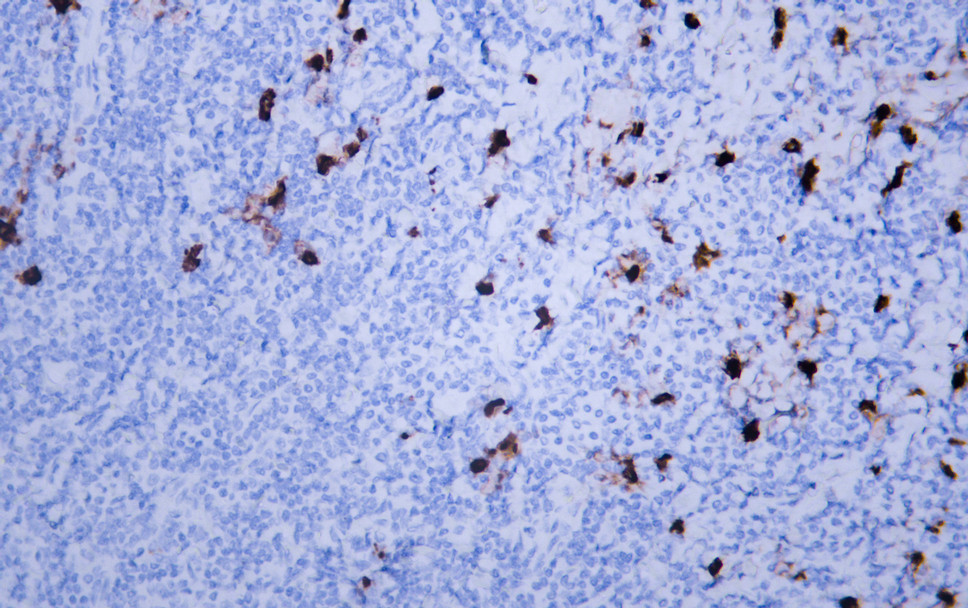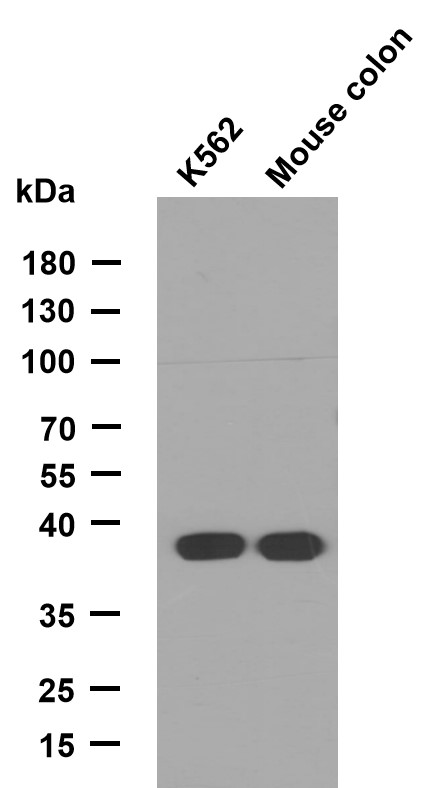Mast cell tryptase (ABT-MCT) mouse mAb
- Catalog No.:YM6194
- Applications:IHC;IF;ELISA
- Reactivity:Human;
- Target:
- Mast cell tryptase
- Fields:
- >>Influenza A
- Gene Name:
- TPSAB1 TPS1 TPS2 TPSB1
- Protein Name:
- Tryptase alpha/beta-1 (Tryptase-1) (EC 3.4.21.59) (Tryptase I) (Tryptase alpha-1)
- Human Gene Id:
- 7177
- Human Swiss Prot No:
- Q15661
- Immunogen:
- Synthesized peptide derived from human Mast cell tryptase AA range: 200-275
- Specificity:
- The antibody can specifically recognize human Mast cell tryptase protein.
- Formulation:
- PBS, 50% glycerol, 0.05% Proclin 300, 0.05%BSA
- Source:
- Mouse, Monoclonal/IgG1, kappa
- Dilution:
- IHC 1:200-400. IF 1:50-200. ELISA 1:500-5000
- Purification:
- The antibody was affinity-purified from ascites by affinity-chromatography using specific immunogen.
- Storage Stability:
- -15°C to -25°C/1 year(Do not lower than -25°C)
- Molecular Weight(Da):
- 30kD
- Observed Band(KD):
- 30kD
- Background:
- Tryptases comprise a family of trypsin-like serine proteases, the peptidase family S1. Tryptases are enzymatically active only as heparin-stabilized tetramers, and they are resistant to all known endogenous proteinase inhibitors. Several tryptase genes are clustered on chromosome 16p13.3. These genes are characterized by several distinct features. They have a highly conserved 3' UTR and contain tandem repeat sequences at the 5' flank and 3' UTR which are thought to play a role in regulation of the mRNA stability. These genes have an intron immediately upstream of the initiator Met codon, which separates the site of transcription initiation from protein coding sequence. This feature is characteristic of tryptases but is unusual in other genes. The alleles of this gene exhibit an unusual amount of sequence variation, such that the alleles were once thought to represent two separate gene
- Function:
- catalytic activity:Preferential cleavage: Arg-|-Xaa, Lys-|-Xaa, but with more restricted specificity than trypsin.,function:Tryptase is the major neutral protease present in mast cells and is secreted upon the coupled activation-degranulation response of this cell type.,function:Tryptase is the major neutral protease present in mast cells and is secreted upon the coupled activation-degranulation response of this cell type. Has an immunoprotective role during bacterial infection. Required to efficiently combat K.pneumoniae infection.,polymorphism:There are two alleles; beta-II and beta-III which differ by 3 residues.,similarity:Belongs to the peptidase S1 family.,similarity:Belongs to the peptidase S1 family. Tryptase subfamily.,similarity:Contains 1 peptidase S1 domain.,subcellular location:Released from the secretory granules upon mast cell activation.,subunit:Homotetramer.,
- Subcellular Location:
- Cytoplasmic
- Expression:
- Isoform 1 and isoform 2 are expressed in lung, stomach, spleen, heart and skin; in these tissues, isoform 1 is predominant. Isoform 2 is expressed in aorta, spleen, and breast tumor, with highest levels in the endothelial cells of some blood vessels surrounding the aorta, as well as those surrounding the tumor and low levels, if any, in mast cells (at protein level).
- June 19-2018
- WESTERN IMMUNOBLOTTING PROTOCOL
- June 19-2018
- IMMUNOHISTOCHEMISTRY-PARAFFIN PROTOCOL
- June 19-2018
- IMMUNOFLUORESCENCE PROTOCOL
- September 08-2020
- FLOW-CYTOMEYRT-PROTOCOL
- May 20-2022
- Cell-Based ELISA│解您多样本WB检测之困扰
- July 13-2018
- CELL-BASED-ELISA-PROTOCOL-FOR-ACETYL-PROTEIN
- July 13-2018
- CELL-BASED-ELISA-PROTOCOL-FOR-PHOSPHO-PROTEIN
- July 13-2018
- Antibody-FAQs
- Products Images

- Human stomach tissue was stained with Anti-Mast Cell Tryptase (ABT-MCT) Antibody

- Human tonsil tissue was stained with Anti-Mast Cell Tryptase (ABT-MCT) Antibody



